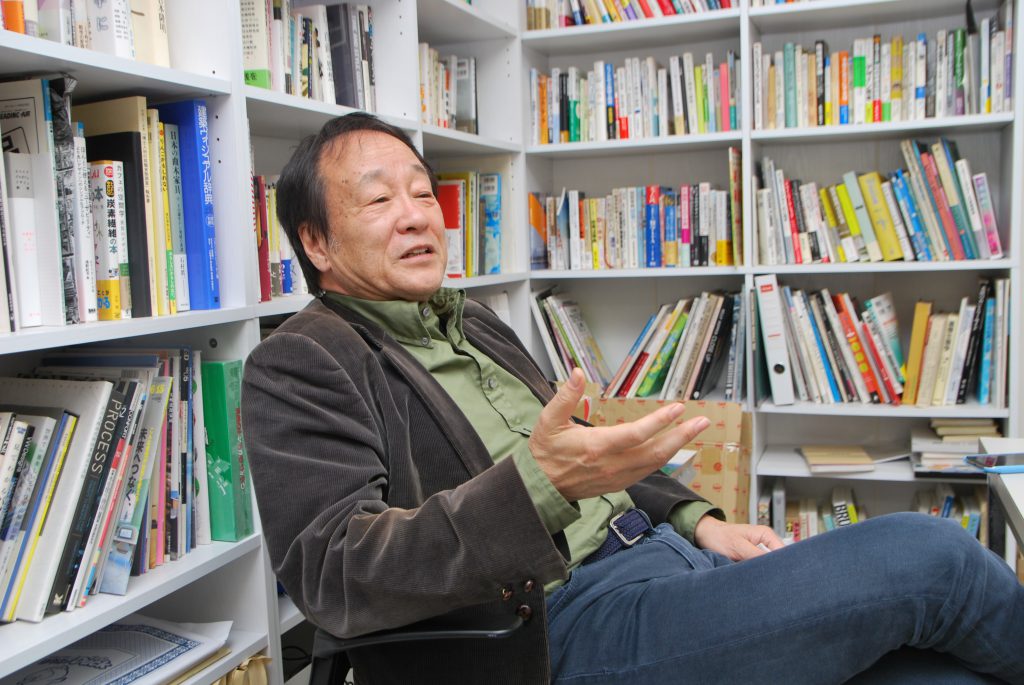Email Magazine
Product Design (2/24/2021)
Nanophoton has commissioned its product design to Associate Professor Yoshito Ogata (Industrial Design) of Kyushu University. Speaking of Nanophoton’s products, their simple design based on white is impressive. This is the result of Chairman Satoshi Kawata’s commitment to “make it easy to recognize Nanophoton products just by looking at them. In this issue, we interviewed Associate Professor Ogata and Chairman Kawada about the design. (e-mail Newsletter editor-in-chief / freelance writer Takeshi Nemoto)

The Graduate School of Art and Design, Kyushu University (located in Minami-ku, Fukuoka City), to which Associate Professor Ogata belongs, was established in 2003 when its predecessor, Kyushu Institute of Design, was combined with Kyushu University. Associate Professor Ogata is also a graduate of Kyushu University of Art and Design.
Associate Professor Ogata: “After graduation, I worked in furniture and interior design. After graduating from the university, I worked in furniture and interior design, and then worked at the design office of Professor Kazuo Kawasaki (currently Professor Emeritus of Osaka University and Professor Emeritus of Nagoya City University), where I studied the design of home appliances and information equipment, as well as his attitude and approach to design. When Professor Kawasaki was invited to become a specially appointed professor at Osaka University, I was a little late in coming to Osaka University as a specially appointed assistant professor.
Mr. Kawata: “To add to this, in 2001, when I was a professor at the Graduate School of Engineering, Osaka University, the Frontier Research Organization was established in the Graduate School of Engineering. The framework of the university cannot be moved easily from the old system of academic disciplines, so it was established to receive other fields.
Nanoscience is one of them. In addition, I wanted to launch the field of design science and engineering. The Faculty of Engineering also needs to change its way of thinking to create fashionable products that people will admire, and I would like to invite such professors. So I suddenly went to the Kawasaki Laboratory at Nagoya City University and asked if they would be interested in coming to Osaka University. That’s how the Kawasaki Laboratory was established at Osaka University.
This is how Associate Professor Ogata met Chairman Kawata and later moved to Kyushu University, where he is involved in product design for Nanophoton.
In a past interview, Mr. Kawata said, “I am very particular about design. “I’m very particular about design. People are attracted to artistic sense. Cars and home appliances do not just need to work or be usable, they need to be cool to sell. I believe that the products we make should also be cool. Within the company, we ask for simple designs and for products that can be recognized as Nanophoton products just by looking at them.

So what are Associate Professor Ogata’s thoughts on design?
Associate Professor Ogata: “The concept of industrial product design is to express the technology without excess or deficiency. If something is small, make it small; if there is a difference in meaning between here and there, make it different; if a new technology has been developed, make sure to convey that it is new. If a new technology has been developed, it is important to convey that it is new. I try to avoid adding decorative elements as much as possible, and consider the balance of proportion and shape. In the case of Nanophoton’s products, Dr. Kawata had been talking about Apple’s products for a while, so I think he had that in mind.
For example, in the case of the wide-field Raman scope RAMANview, we were first shown the drawing and worked to come up with a shape that would convey the engineer’s design well. We looked for a large outer shape, and once we had a rough idea of what the shape would look like, we adjusted the dimensions to find a proportion that would look good, and thought about what parts should be shown and what parts should not. I designed while communicating with the engineers.
From a design standpoint, how does the Nanophoton device look like?
Associate Professor Ogata: “I can clearly see the parts that the engineers and designers are particular about. They are clear about which parts they absolutely cannot change, and which parts they can change according to what the designer says. What they want to engineer is clear. I think they are confident as engineers. That’s why I feel comfortable designing for them.
Chairman Kawata: “My understanding is that Nanophoton is a small company, so the distance between engineers and users is close. In a large company, there is a sense of distance between the manufacturer and the sales person, but in our case, the engineers are close to the user’s needs, and we have to make it easy to use.
Mr. Kawata: “One of the features of our equipment is that the CCDs in the detectors are mounted externally, probably because Mr. Ogata told us to do so.
Associate Professor Ogata: “I remember now. When I was first shown the CCD at a meeting, I felt that it would be interesting to show the CCD as it is. I thought that if we showed the CCD, we could change the meaning and shape of the CCD.
Finally, when I asked Associate Professor Ogata about his self-evaluation of the design, this was his answer.
Associate Professor Ogata: “I was happy when a company once consulted me and said, ‘We want to create something like Nanophoton.


